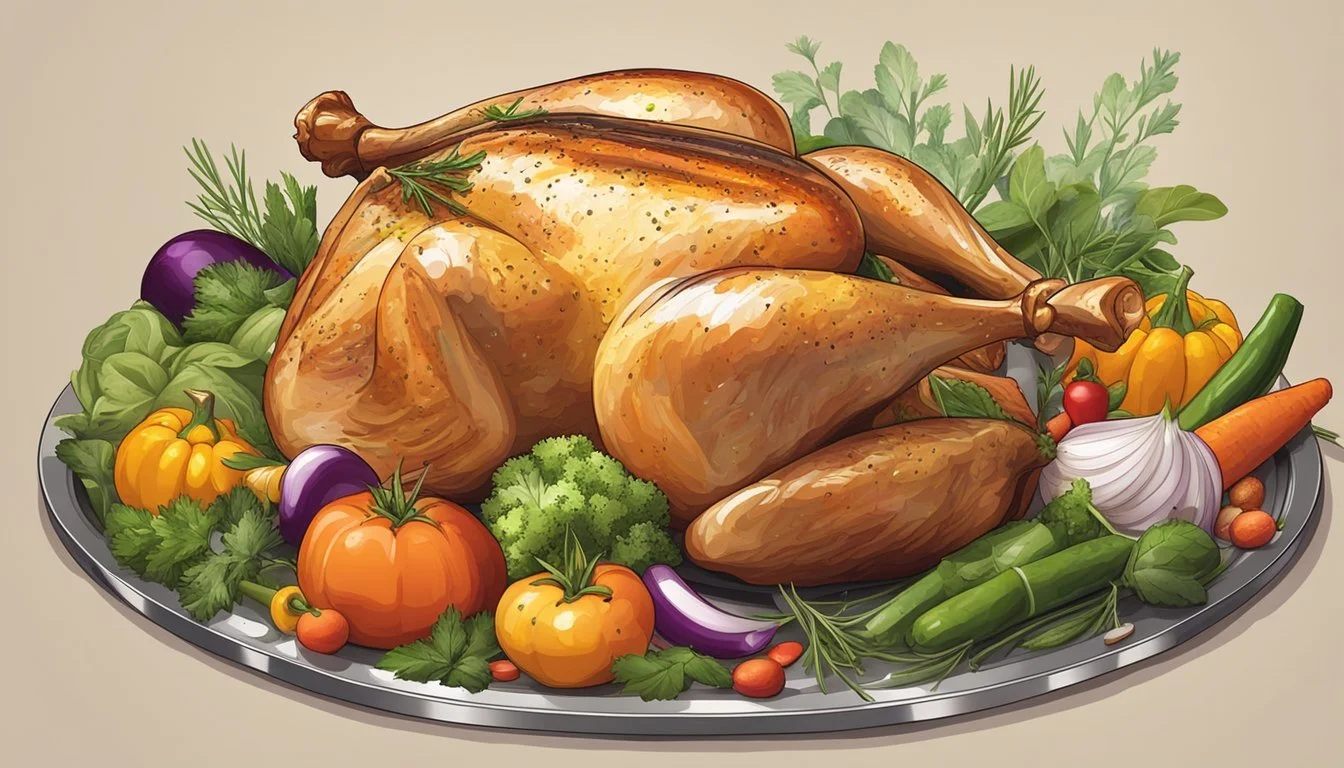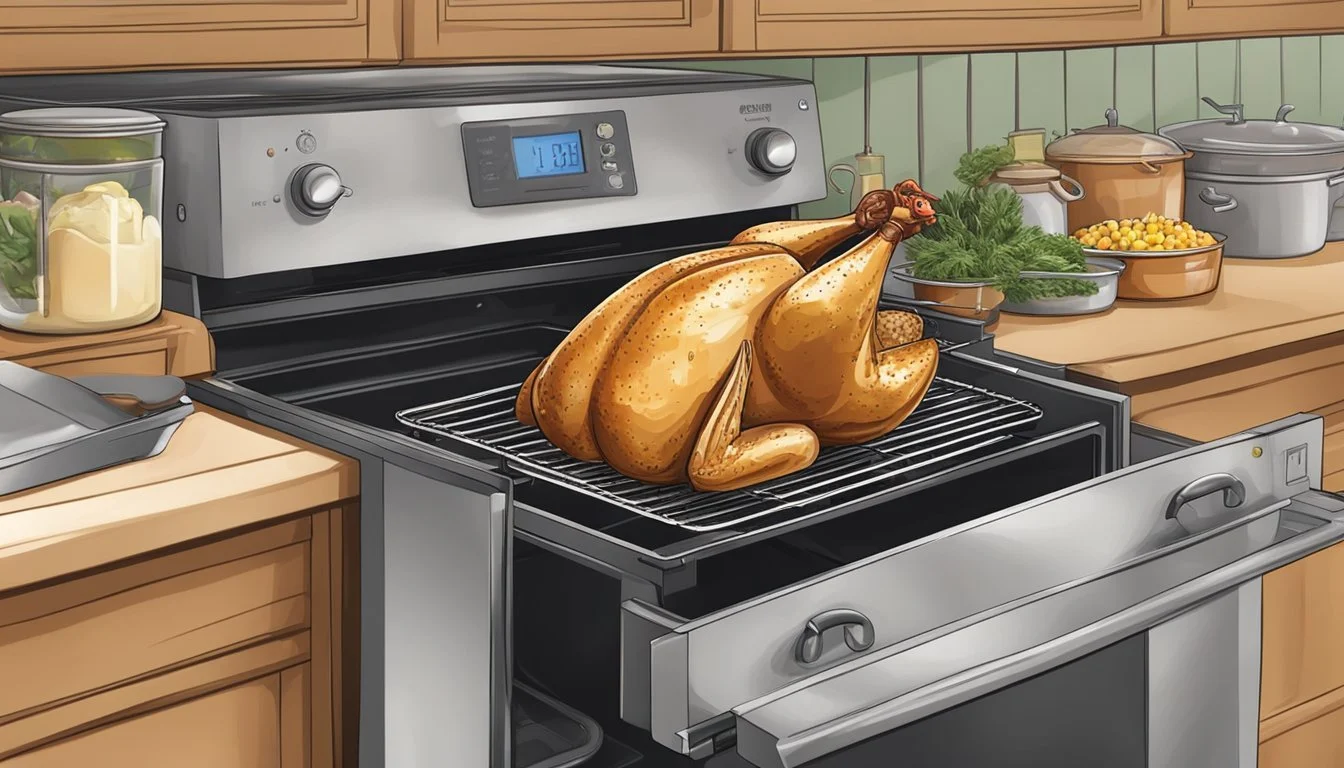How to Cook a Whole Chicken
Juicy and Flavorful Results Every Time
Cooking a whole chicken is a classic culinary skill that yields delicious results. The process involves seasoning and roasting a bird to achieve crispy, golden-brown skin and juicy, tender meat. A perfectly cooked whole chicken can be prepared in about an hour, using simple ingredients like salt, butter, and herbs.
Roasting a whole chicken in the oven offers versatility and flavor. The high heat helps create a crisp exterior while keeping the inside moist. Seasonings can be customized to suit different tastes, from simple salt and pepper to more complex herb blends. The resulting dish provides a centerpiece for family meals and generates leftovers for additional recipes.
Mastering the art of cooking a whole chicken opens up a world of culinary possibilities. The techniques learned can be applied to other poultry and roasted meats. With practice, home cooks can consistently produce restaurant-quality roasted chicken, impressing guests and satisfying hungry family members.
Selecting the Chicken
Choosing the right chicken is crucial for a successful roast. The size and quality of the bird impact cooking time, flavor, and overall satisfaction.
Understanding Chicken Sizes and Labels
Chickens come in various sizes to suit different needs. A 3-4 pound chicken serves 2-4 people, making it ideal for small families or weeknight dinners. Larger 5-6 pound birds are better for gatherings or meal prep.
Labels provide important information. "Free-range" chickens have outdoor access, while "organic" birds are raised without antibiotics or hormones. "Air-chilled" chickens often have crispier skin when roasted.
Look for plump breasts, firm legs, and a yellow hue. Avoid chickens with bruises or discoloration. The skin should be intact and free from tears.
Fresh vs. Frozen Chicken
Fresh chickens offer convenience and immediate use. They typically have better texture and flavor. However, they have a shorter shelf life and must be used within a few days of purchase.
Frozen chickens provide flexibility and longer storage. They're often more affordable and available year-round. Proper thawing is crucial for food safety and even cooking.
When choosing between fresh and frozen, consider your meal plans and storage capacity. Fresh is best for immediate use, while frozen works well for future meals or bulk buying.
Preparation Steps
Properly preparing a whole chicken is crucial for achieving a delicious result. The key steps involve safely defrosting the bird, cleaning it thoroughly, and applying flavorful seasonings.
Defrosting Safely
Remove the chicken from the freezer and place it in the refrigerator 24-48 hours before cooking, depending on size. This slow thawing method prevents bacterial growth. For faster defrosting, submerge the sealed chicken in cold water, changing it every 30 minutes.
Never thaw chicken at room temperature. Once defrosted, use within 1-2 days.
Cleaning and Drying
Remove giblets and neck from the cavity. Rinse the chicken inside and out under cold running water. Pat dry thoroughly with paper towels, paying attention to the cavity.
Drying helps achieve crispy skin during roasting. Place the dried chicken on a clean cutting board or in a roasting pan.
Seasonings and Flavorings
Season the chicken generously inside and out with kosher salt and freshly ground black pepper. This enhances flavor and helps crisp the skin.
Rub herbs, minced garlic, or lemon zest under the skin for added flavor. Popular herb choices include rosemary, thyme, and sage.
Consider stuffing the cavity with aromatics like lemon halves, garlic cloves, or herb sprigs. These infuse flavor from the inside.
For extra moisture and flavor, brush the skin with melted butter or olive oil before seasoning.
Roasting Techniques
Mastering roasting techniques is key to achieving a perfectly cooked whole chicken with juicy meat and crispy skin. The right methods ensure even cooking and optimal flavor.
Oven Roasting Basics
Preheat the oven to 425°F (218°C) for optimal roasting. Place the chicken breast-side up in a roasting pan. For even cooking, truss the legs together with kitchen twine. Rub the skin with olive oil or softened butter to promote browning and crispiness.
Season generously with salt and pepper, both inside and out. Insert aromatics like lemon, garlic, or herbs into the cavity for added flavor. Roast for about 20 minutes per pound, or until the internal temperature reaches 165°F (74°C) in the thickest part of the thigh.
Use a meat thermometer to ensure doneness. Let the chicken rest for 10-15 minutes before carving to allow juices to redistribute.
Basting and Moisture Retention
Basting helps maintain moisture and enhances flavor during roasting. Every 20-30 minutes, spoon pan juices or melted butter over the chicken. This keeps the meat juicy and promotes a golden-brown skin.
For extra moisture, add a cup of chicken broth or white wine to the roasting pan. This creates steam and prevents the chicken from drying out. Another effective method is to place butter or herb-infused oil under the skin before roasting.
Cover the chicken loosely with foil if it browns too quickly. Remove the foil for the last 15-20 minutes to crisp up the skin. These techniques result in a succulent, flavorful roast chicken.
Monitoring and Safety
Properly monitoring a whole chicken during cooking is crucial for both safety and optimal results. Using thermometers correctly and identifying doneness are key skills for any home cook.
Using Thermometers Correctly
Insert an instant-read thermometer into the thickest part of the chicken, typically the breast, without touching bone. For accurate readings, push the probe in about 2 inches deep. Avoid inserting near fat or gristle.
Check multiple spots to ensure even cooking. The thigh is another good testing location. Clean the thermometer between readings to prevent cross-contamination.
Digital thermometers offer quick, precise measurements. For continuous monitoring, use a leave-in probe thermometer. Place it before cooking and set an alarm for the target temperature.
Identifying Doneness
The safe internal temperature for chicken is 165°F (74°C). At this point, harmful bacteria are destroyed. The thickest part should reach this temperature.
Clear juices are not a reliable indicator of doneness. Always use a meat thermometer for accuracy. Chicken can still be pink at the bone when fully cooked.
Let the chicken rest for 3-5 minutes after reaching 165°F. During this time, the temperature may rise slightly. This resting period allows juices to redistribute, resulting in moister meat.
Check the temperature of any stuffing separately. It should also reach 165°F for safety.
Resting and Carving
After roasting a whole chicken, proper resting and carving techniques are crucial for optimal flavor and texture. These steps ensure the juices redistribute and make cutting easier.
The Importance of Resting
Resting a roasted chicken is essential for maintaining its juiciness. After removing the bird from the oven, let it rest for 10-15 minutes. This allows the meat fibers to relax and reabsorb the juices.
Place the chicken on a cutting board with a rim to catch any drippings. Loosely tent it with aluminum foil to keep it warm without trapping steam, which can soften the crispy skin.
Resting also makes carving easier, as the meat becomes firmer and less likely to shred. Use this time to prepare side dishes or gather carving tools.
Carving Techniques
Proper carving techniques enhance presentation and make serving easier. Start by removing the legs. Cut through the skin between the leg and body, then gently pull the leg away to expose the joint.
Cut through the joint to separate the leg. Repeat on the other side. Next, slice along the breastbone to remove the breast meat in whole pieces.
Use a sharp knife for clean cuts. Remove the wings by cutting through the joint where they meet the body.
For leftovers, consider removing all remaining meat from the bones. Store in airtight containers in the refrigerator for up to 3-4 days.
Serve and Accompaniments
A perfectly roasted chicken deserves complementary sides and an appealing presentation. The right accompaniments enhance the meal while thoughtful plating elevates the dining experience.
Pairing with Sides
Roasted potatoes make an excellent side for chicken. Toss cubed potatoes with olive oil, salt, and herbs before roasting until crispy. For a lighter option, serve a mixed green salad with a tangy vinaigrette.
Rice pilaf or quinoa provide hearty grain options. Steamed vegetables like broccoli or green beans add color and nutrition. Roasted root vegetables such as carrots and parsnips offer a sweet contrast to savory chicken.
Don't forget the gravy. Make a simple pan sauce by deglazing the roasting pan with chicken broth and thickening with flour. Season with herbs for extra flavor.
Presentation Tips
Carve the chicken into neat slices and arrange on a warmed platter. Garnish with fresh herbs like rosemary or thyme for visual appeal.
Place side dishes in separate serving bowls around the chicken. Use colorful vegetables to create an appetizing color palette on the table.
Consider stuffing the chicken cavity with lemon halves and herbs before roasting. This adds flavor and creates an attractive presentation when the bird is brought to the table whole.
Serve gravy in a sauce boat alongside the chicken. Provide a variety of serving utensils to make it easy for diners to help themselves.
Storage and Leftovers
Proper storage ensures leftover chicken stays fresh and safe to eat. Careful reheating preserves its flavor and texture for enjoyable meals.
Preserving Leftover Chicken
Store leftover roast chicken in an airtight container in the refrigerator within 2 hours of cooking. Refrigerated cooked chicken remains safe to eat for 3-4 days. For longer storage, freeze chicken in airtight containers or freezer bags for up to 4 months.
Remove chicken from the bone before storing to save space. Separate chicken into meal-sized portions for easier thawing and reheating. Label containers with the date to track freshness.
Discard chicken that has been left at room temperature for over 2 hours. Signs of spoilage include off odors, slimy texture, or visible mold.
Reheating Without Drying Out
Reheat chicken to an internal temperature of 165°F (74°C) to ensure food safety. Use a meat thermometer to check.
Microwave: Place chicken on a microwave-safe plate. Cover with a damp paper towel to retain moisture. Heat in 30-second intervals, turning occasionally.
Oven: Wrap chicken in foil with a splash of broth or water. Heat at 350°F (175°C) for 10-15 minutes.
Stovetop: Slice chicken thinly. Sauté in a pan with a small amount of oil or butter over medium heat until warmed through.
Repurpose leftover chicken in soups, salads, or nachos for added flavor and convenience.





